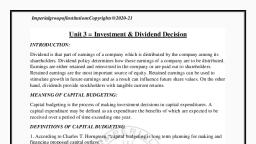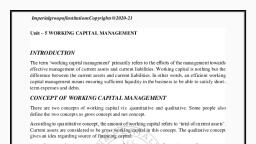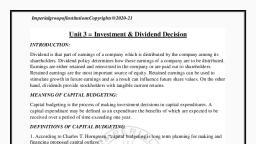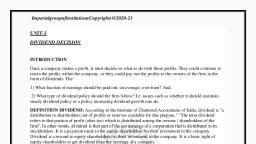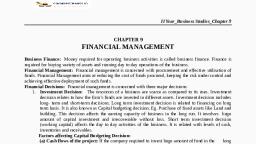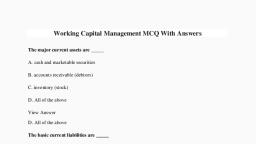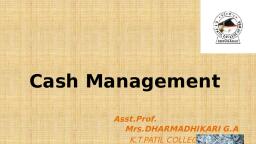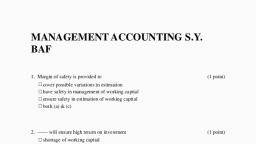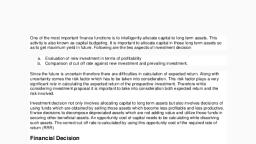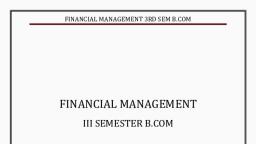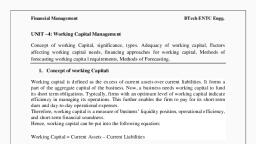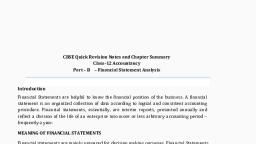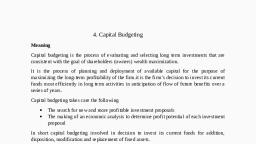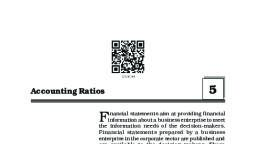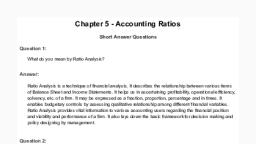Page 1 :
ImperialgroupofinstitutionsCopyrights@2020-21, Unit – 5 WORKING CAPITAL MANAGEMENT, , INTRODUCTION, The term ‘working capital management’ primarily refers to the efforts of the management towards, effective management of current assets and current liabilities. Working capital is nothing but the, difference between the current assets and current liabilities. In other words, an efficient working, capital management means ensuring sufficient liquidity in the business to be able to satisfy shortterm expenses and debts., , CONCEPT OF WORKING CAPITAL MANAGEMENT, There are two concepts of working capital viz .quantitative and qualitative. Some people also, define the two concepts as gross concept and net concept., According to quantitative concept, the amount of working capital refers to ‘total of current assets’., Current assets are considered to be gross working capital in this concept. The qualitative concept, gives an idea regarding source of financing capital., According to qualitative concept the amount of working capital refers to “excess of current assets, over current liabilities.” L.J. Guttmann defined working capital as “the portion of a firm’s current, assets which are financed from long–term funds.” The excess of current assets over current, liabilities is termed as ‘Net working capital’. In this concept “Net working capital” represents the, amount of current assets which would remain if all current liabilities were paid., Current assets – It is rightly observed that “Current assets have a short life span. These type of, assets are engaged in current operation of a business and normally used for short– term operations, of the firm during an accounting period i.e. within twelve months. The two important, characteristics of such assets are, (i) short life span, and (ii) swift transformation into other form, of assets. Cash balance may be held idle for a week or two; account receivable may have a life, span of 30 to 60 days, and inventories may be held for 30 to 100 days., Current liabilities – The firm creates a Current Liability towards creditors (sellers) from whom it, has purchased raw materials on credit. This liability is also known as accounts payable and shown, in the balance sheet till the payment has been made to the creditors. The claims or obligations, which are normally expected to mature for payment within an accounting cycle (1 year) are known, as current liabilities. These can be defined as “those liabilities where liquidation is reasonably, expected to require the use of existing resources properly classifiable as current assets, or the, creation of other current assets, or the creation of other current liabilities.”, , CHANDRAKALA R, , Asst. Professor IGI.
Page 2 :
ImperialgroupofinstitutionsCopyrights@2020-21, , CHART OF DIFFERENCE BETWEEN CURRENT ASSETS AND CURRENT, LIABILITIES: –, Basis, Difference, , of, , Current Assets, , Current Liabilities, , Meaning, , These assets are used or utilized within the Current liabilities are a type of loan that must, period of one year., be repaid within one year (maximum 1 year)., , Also known as, , These are also known as Short Term Assets., , These are also known as Short Term, Liabilities., , Part off, , These assets are a part of Total assets., , These Liabilities are a part of Total Liabilities., , Financial, Statement, Need, Calculation, , Examples, , These assets are shown separately on the right These Liabilities are shown separately on the, side of the Balance sheet., left side of the Balance sheet., for These are calculated to know the ability of the These are calculated to know the current total, outstanding amount which the business has to, business of liquidity., pay in the future., , These assets have included cash, bank These liabilities have included short terms, balance, sundry debtors, inventory, or prepaid loans, Sundry Creditors & Outstanding, expenses., expenses., , FACTORS AFFECTING WORKING CAPITAL REQUIREMENTS, The working capital requirement of a concern depends upon a large numbers of factors. These are:, 1. Nature or Character of Business: The working capital requirement of a firm basically depends, upon the nature of this business. Public utility undertakings like electricity water supply and, railways need very limited working capital because they offer cash sales only and supply services,, not products and as such no funds are tied up in inventories and receivables. Generally speaking it, may be said that public utility undertakings require small amount of working capital, trading and, financial firms require relatively very large amount, whereas manufacturing undertakings require, sizable working capital between these two types of business., 2. Scale of Operations: The working capital requirement of a concern is directly influenced by, the size of its business which may be measured in terms of scale of operations, 3. Length of Production Cycle: In manufacturing business the requirement of working capital, increases in direct proportion of length of manufacturing process. Longer the process period of, manufacture, larger is the amount of working capital required., CHANDRAKALA R, , Asst. Professor IGI.
Page 3 :
ImperialgroupofinstitutionsCopyrights@2020-21, 4. Seasonal Variation: In certain industries raw material is not available throughout the year., They have to buy raw materials in bulk during the season to ensure and uninterrupted flow and, process them during the entire year., 5. Stock Turnover: There is a high degree of inverse co-relationship between the quantum of, working capital; and the velocity or speed with which the sales are affected. A firm having a high, rate of stock turnover will need less amount of working capital., 6. Credit Policy: The credit policy of a concern in its dealing with debtors and creditors influence, considerably the requirement of working capital. A concern that purchases its requirement on, credit and sell its products/services on cash require lesser amount of working capital and vice, versa., 7. Business Cycle: Business cycle refers to alternate expansion and contraction in general business, activity. In a period of boom i.e., when the business is prosperous, there is a need of larger amount, of working capital due to increase in sales, rise in prices., 8. Rate of Growth of Business: The working capital requirement of a concern increase with the, growth and expansion of its business activities., , PRINCIPLES OF WORKING CAPITAL MANAGEMENT:, 1. Principle of Optimization: The level of working capital must be so kept that the rate of return on, investment is optimized. In other words, the working capital should be maintained at an optimum, level. This is the point at which the increase in cost due to decline in working capital is equal to, the increase in the gain associated with it. According to the principle of optimization, the, magnitude of working capital should be such that each rupee invested adds to its net value. In other, words capital should be invested in each component of working capital as long as the equity, position of firm increases.”, 2. Principle of Risk Variation: This principle is based on the assumption that the rate of return on, investment is linked with degree of risk in the business. Risk here refers to the inability of firm to, maintain sufficient current assets to pay its obligations. If working capital is varied relative to sales,, the amount of risk that a firm assumes is also varied and the opportunity for gain or loss is, increased. In other words, there is a definite relationship between the degree of risk and the rate of, return. As a firm assumes more risk, the opportunity for gain or loss increases. As the level of, working capital relative to sales decreases, the degree of risk increases. When the degree of risk, increases, the opportunity for gain and loss also increases. Thus, if the level of working capital, goes up, amount of risk goes down, and vice-versa, the opportunity for gain is like-wise adversely, affected., 3. Principle of Cost of Capital: Each source of working capital has different cost of capital. The, degree of risk also differs from one source to another. The type of capital used to finance working, capital directly affects the amount of risk that a firm assumes as well as the opportunity for gain, or loss and cost of capital. A firm should raise capital in such a manner that a balance is maintained, between risk and profit., 4. Principle of Maturity of Payment: This principle states that the working capital should be so, raised from different sources that the firm is able to repay them on maturity out of its inflows of, funds. Otherwise the firm would fail to repay on maturity and ultimately, it would find itself into, CHANDRAKALA R, , Asst. Professor IGI.
Page 4 :
ImperialgroupofinstitutionsCopyrights@2020-21, liquidation though it is earning huge profits. This implies that the firm’s ability to repay its shortterm debts depends not on its earnings but on the flow of cash into it., 5. Principle of Equity Position: According to this principle, the amount of working capital invested, in each component should be adequately justified by a firm’s equity position. Every rupee invested, in the working capital should contribute to the net worth of the firm., , TYPES OF WORKING CAPITAL, According to the needs of business, the working capital may be classified into following two basis:, 1) On the basis of periodicity, 2) On the basis of concept, On the basis of periodicity:, The requirements of working capital are continuous. More working capital is required in a, particular season or the peck period of business activity. On the basis of periodicity working capital, can be divided under two categories as under:, 1. Permanent working capital, 2. Variable working capital, (a) Permanent working capital: This type of working capital is known as Fixed Working Capital., Permanent working capital means the part of working capital which is permanently locked up in, the current assets to carry out the business smoothly. The minimum amount of current assets which, is required to conduct the business smoothly during the year is called permanent working capital., For example, investments required to maintain the minimum stock of raw materials or to cash, balance. The amount of permanent working capital depends upon the size and growth of company., Fixed working capital can further be divided into two categories as under:, 1. Regular Working capital: Minimum amount of working capital required to keep the primary, circulation. Some amount of cash is necessary for the payment of wages, salaries etc., 2. Reserve Margin Working capital: Additional working capital may also be required for, contingencies that may arise any time. The reserve working capital is the excess of capital over, the needs of the regular working capital is kept aside as reserve for contingencies, such as strike,, business depression etc., (b) Variable or Temporary Working Capital: The term variable working capital refers that the, level of working capital is temporary and fluctuating. Variable working capital may change from, one assets to another and changes with the increase or decrease in the volume of business., The variable working capital may also be subdivided into following two sub-groups., 1. Seasonal Variable Working capital: Seasonal working capital is the additional amount which, is required during the active business seasons of the year. Raw materials like raw-cotton or jute or, sugarcane are purchased in particular season. The industry has to borrow funds for short period. It, CHANDRAKALA R, , Asst. Professor IGI.
Page 5 :
ImperialgroupofinstitutionsCopyrights@2020-21, is particularly suited to a business of a seasonal nature. In short, seasonal working capital is, required to meet the seasonal liquidity of the business., 2. Special variable working capital: Additional working capital may also be needed to provide, additional current assets to meet the unexpected events or special operations such as extensive, marketing campaigns or carrying of special job etc., , On the basis of concept:, On the basis of concept working capital is divided into two categories as under:, (A) Gross Working Capital: Gross working capital refers to total investment in current assets., The current assets employed in business give the idea about the utilization of working, capital and idea about the economic position of the company. Gross working capital, concepts is popular and acceptable concept in the field of finance., (B) Net Working Capital: Net working capital means current assets minus current liabilities., The difference between current assets and current liabilities is called the net working, capital. If the net working capital is positive, business is able to meet its current liabilities., Net working capital concept provides the measurement for determining the, creditworthiness of company., , SOURCES OF WORKING CAPITAL, I., Short-Term Financing:, Short-term sources can be further divided into internal and external sources of working capital, finance. Short-term internal sources include tax provisions, dividend provisions, etc. Short-term, external sources include short-term working capital financing from banks such as bank overdrafts,, cash credits, trade deposits, bills discounting, and short-term loans, inter corporate loans,, commercial paper, etc., 1. Inter Corporate Loans:, These are unsecured short-term funds raised by one firm from another firm. They are dependent, on personal contacts. They are for a very short period of time, that is, 3 months or 6 months and, are not regulated by any law. They involve high risk, but are useful in solving temporary capital, crisis., 2. Commercial Paper:, It is an unsecured promissory note issued by large banks and corporation that enjoy sound credit, ratings. These are issued at a discount and are backed by a corporation’s promise to pay face value, on the maturity date of the commercial note., 3. Trade Credit:, It is a primary source of financing working capital in India. It is an arrangement in which a firm, buys goods or services without making immediate cash payment. If a firm buys raw materials from, CHANDRAKALA R, , Asst. Professor IGI.
Page 6 :
ImperialgroupofinstitutionsCopyrights@2020-21, the suppliers on credit basis, it gets the raw material for utilization immediately with the facility to, make the delayed payment. By accepting the delay in payment, the suppliers of raw material, finance the requirement of working capital., 4. Bank Overdraft:, An overdraft is an agreement by a bank to allow a firm to borrow up to a certain limit. The firm, will borrow as much or as little as it needs up to the overdraft limit and the bank charges daily, interest at a variable rate on the debt outstanding. The bank may also require security (or collateral), as a protection against the risk of non-payment by the firm. An overdraft is a flexible source of, finance as a firm uses it only when the need arises., 5. Loan:, It is a fixed amount of debt finance borrowed by a firm from a bank, with repayment to be made, in the near future, for example, after one year. The firm pays interest on the loan at either a fixed, or a floating (that is, variable) rate at regular intervals, for instance, quarterly., 6. Letter of Credit:, It is a document that a financial institution issues to a seller of goods or services which says that, the issuer will pay the seller for goods/services the seller delivers to a third-party buyer. The issuer, then seeks reimbursement from the buyer or from the buyer’s bank. The document is essentially a, guarantee to the seller that it will be paid by the issuer of the Letter of Credit, upon the failure of, the buyer to pay., II. Long-Term Financing:, (a) Shares:, Issue of shares is the most important source for raising the permanent or long-term capital. A firm, may issue equity shares or preference shares. Preference shares carry preferential rights in respect, of dividend at a fixed rate and with regard to the repayment of capital at the time of winding up, the firm., (b) Debentures:, A debenture is an instrument issued by the firm acknowledging its debt to its holder. It is also an, important method of raising long-term or permanent working capital. The debenture-holders are, the creditors of the firm. A fixed rate of interest is paid on debentures. The interest on debentures, is a tax deductible charge against profit and loss account., (c) Term Loan:, It is a loan with a repayment period of more than one year. It is usually taken by firms with longer, investment or payback horizons, such as the building of a new factory or purchase of new, production equipment. A bank term loan is usually repaid via periodic installments., (d) Public Deposits:, CHANDRAKALA R, , Asst. Professor IGI.
Page 7 :
ImperialgroupofinstitutionsCopyrights@2020-21, These are the fixed deposits accepted by a business enterprise directly from the public. This source, of raising short-term and medium-term finance was very popular in the absence of banking, facilities., (e) Retained Earnings:, This involves ploughing back of profits, which means reinvesting surplus earnings in its business., It is an internal source of finance and is most suitable for an established firm for its expansion,, modernization and replacement etc. This is the cheapest source of finance. There is no need to, keep securities and there is no dilution of control., , METHODS FOR ESTIMATING WORKING CAPITAL, The following methods are used to calculate the amount of working capital requirement in a, business, 1. Operating cycle concept: In this method, the estimates of working capital requirements on the, basis of average holding period of current assets and relating them to costs based on company’s, expectations and experiences. This value of total current assets is known as gross working capital., From gross working capital, the expected current liabilities like sundry creditors for raw materials,, expenses, etc. are deducted to find net working capital. This is the most appropriate method of, calculating working capital, 2. Current assets holding period Method: This method is based on operating cycle period. Here,, the working capital requirement equals to gross working capital requirement., 3. Ratio to sales method: The working capital requirements are estimated as a ratio of sales for, each component of working capital., 4. Ratio of fixed investment method: The working capital is estimated as a percentage of fixed, investment., , ADVANTAGES OF ADEQUATE WORKING CAPITAL, (1) Availability of Raw Materials Regularly: Adequacy of working capital makes it possible for, a firm to pay the suppliers of raw materials on time. As a result it will continue to receive regular, supplies of raw materials and thus there will be no disruption in production process., (2) Full Utilisation of Fixed Assets: Adequacy of working capital makes it possible for a firm to, utilize its fixed assets fully and continuously. For example, if there is inadequate stock of raw, material, the machines will not be utilized in full and their productivity will be reduced., (3) Cash Discount: A firm having the adequate working capital can avail the cash discount by, purchasing the goods for cash or by making the payment before the due date., , CHANDRAKALA R, , Asst. Professor IGI.
Page 8 :
ImperialgroupofinstitutionsCopyrights@2020-21, (4) Increase in Credit Rating: Paying its short-term obligations in time leads to a strong credit, rating which enables the firm to purchase goods on credit on favorable terms and to maintain its, line of credit with banks etc. its facilitates the taking of loan in case of need., (5) Facilitates Distribution of Dividends: Occasionally, inspite of sufficient profits, management, faces difficulty in paying a proper rate of dividend to the shareholders because of paucity of cash., Adequacy of working capital facilitates the payment of dividend., (6) Facility in Obtaining Bank Loans: Banks do not hesitate to advance even the unsecured loan, to a firm which has the sufficient working capital. This is because the excess of current assets over, current liabilities itself is a good security., (7)Increase in Efficiency of Management: Adequacy of working capital has a favorable, psychological effect on the managers. This is because no obstacle arises in the day-to-day business, operations. Creditors, wages and all other expenses are paid on time and hence it keeps morale of, managers high., (8) Meeting Unseen Contingencies: Adequacy of working capital enables a company to meet the, unseen contingencies successfully., , DISADVANTAGES OF INADEQUATE WORKING CAPITAL, (i)Difficulty in Availability of Raw-Materials: Inadequacy of working capital results in nonpayment of creditors on time. As a result the credit purchase of goods on favorable terms becomes, increasingly difficult. Also, the firm cannot avail the cash discount., (ii)Full Utilisation of Fixed Assets not Possible: Due to the frequent interruptions in the supply, of raw materials and paucity of stock, the firm cannot make full utilisation of its machines etc., (iii)Difficulty in the Management of Machinery: Due to the inadequacy of working capital,, machines are not cared and maintained properly which results in the closure of production on many, occasions., (iv)Decrease in Credit Rating: Because of inadequacy of working capital, firm is unable to pay, its short-term obligations on time. It decays the firm’s relations with its bankers and it becomes, difficult for the firm to borrow in case of need., (v) Non utilisation of Favorable Opportunities: for example, a firm cannot purchase sufficient, quantity of raw materials in case of sudden decrease in the prices. Similarly, if the receives a big, order, it cannot execute it due to shortage of working capital., (vi)Decrease in Sales: Due to shortage of working capital, the firm cannot keep sufficient stock, of finished goods. It results in the decrease in sales. Also, the firm will be forced to restrict its, credit sales. This will further reduce the sales., (vii) Difficulty in Distribution of Dividends: Because of paucity of cash resources, firm will not, be able to pay the dividends to its shareholders., , CHANDRAKALA R, , Asst. Professor IGI.
Page 9 :
ImperialgroupofinstitutionsCopyrights@2020-21, (viii) Decrease in the Efficiency of Management: It will become increasingly difficult for, the management to pay its creditors on time and pay its day to day expenses. It will also be, difficult to pay the wages regularly which will have an adverse effect on the morale of, managers., SIGNIFICANCE OF WORKING CAPITAL, 1. Cash Discount:, If a proper cash balance is maintained, the business can avail the advantage of cash discount, by paying cash for the purchase of raw materials and merchandise. It will result in reducing, the cost of production., 2. It creates a Feeling of Security and Confidence:, The proprietor or officials or management of a concern are quite carefree, if they have, proper working capital arrangements because they need not worry for the payment of, business expenditure or creditors. Adequate working capital creates a sense of security,, confidence and loyalty, not only throughout the business itself, but also among its, customers, creditors and business associates., 3. ‘Must’ for Maintaining Solvency and Continuing Production:, In order to maintain the solvency of the business, it is but essential that the sufficient, amount t of fund is available to make all the payments in time as and when they are due., Without ample working capital, production will suffer, particularly in the era of cut throat, competition, and a business can never flourish in the absence of adequate working capital., 4. Sound Goodwill and Debt Capacity:, It is common experience of all prudent businessmen that promptness of payment in, business creates goodwill and increases the debt of the capacity of the business. A firm can, raise funds from the market, purchase goods on credit and borrow short-term funds from, bank, etc. If the investor and borrowers are confident that they will get their due interest, and payment of principal in time., 5. Easy Loans from the Banks:, An adequate working capital i.e. excess of current assets over current liabilities helps the, company to borrow unsecured loans from the bank because the excess provides a good, security to the unsecured loans, Banks favor in granting seasonal loans, if business has a, good credit standing and trade reputation., CHANDRAKALA R, , Asst. Professor IGI.
Page 10 :
ImperialgroupofinstitutionsCopyrights@2020-21, 6., , Distribution of Dividend:, If company is short of working capital, it cannot distribute the good dividend to its, shareholders inspite of sufficient profits. Profits are to be retained in the business to make, up the deficiency of working capital. On the other contrary, if working capital is sufficient,, ample dividend can be declared and distributed. It increases the market value of shares., , 7. Exploitation of Good Opportunity:, In case of adequacy of capital in a concern, good opportunities can be exploited e.g.,, company may make off-season purchases resulting in substantial savings or it can fetch big, supply orders resulting in good profits., 8. Meeting Unseen Contingency:, Depression shoots the demand of working capital because sock piling of finished goods, become necessary. Certain other unseen contingencies e.g., financial crisis due to heavy, losses, business oscillations, etc. can easily be overcome, if company maintains adequate, working capital., 9. High Morale:, The provision of adequate working capital improves the morale of the executive because, they have an environment of certainty, security and confidence, which is a great, psychological, factor in improving the overall efficiency of the business and of the person, who is at the hell of fairs in the company., 10. Increased Production Efficiency:, A continuous supply of raw material, research programme, innovations and technical, development and expansion programmes can successfully be carried out if adequate, working capital is maintained in the business. It will increase the production efficiency,, which will, in turn increases the efficiency and morale of the employees and lower costs, and create image among the community., , CHANDRAKALA R, , Asst. Professor IGI.

